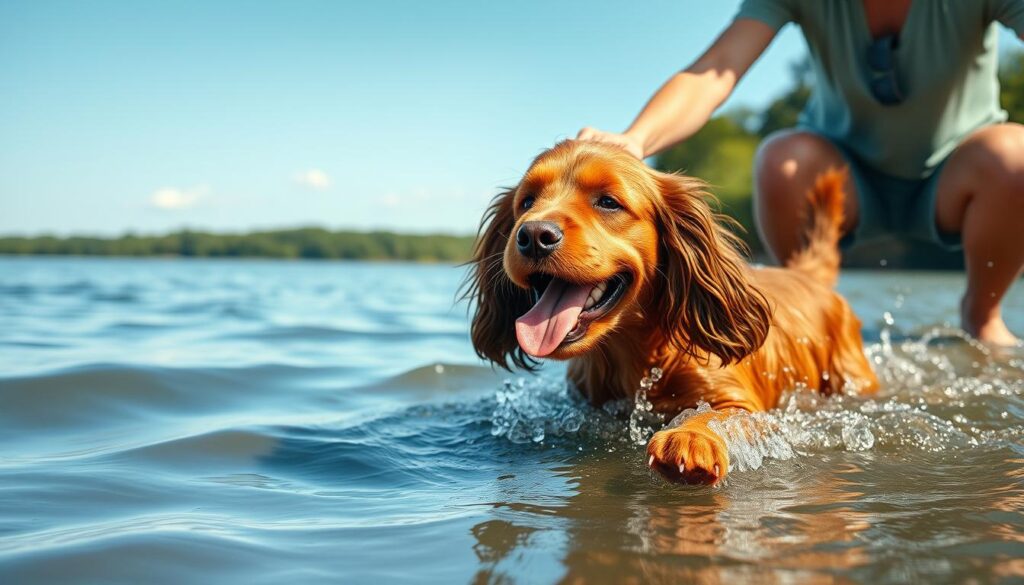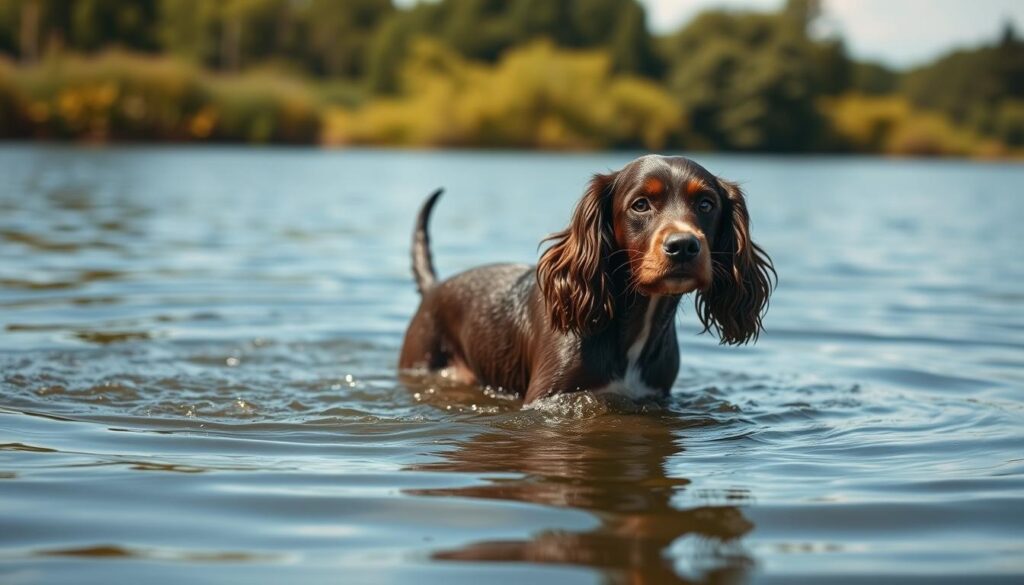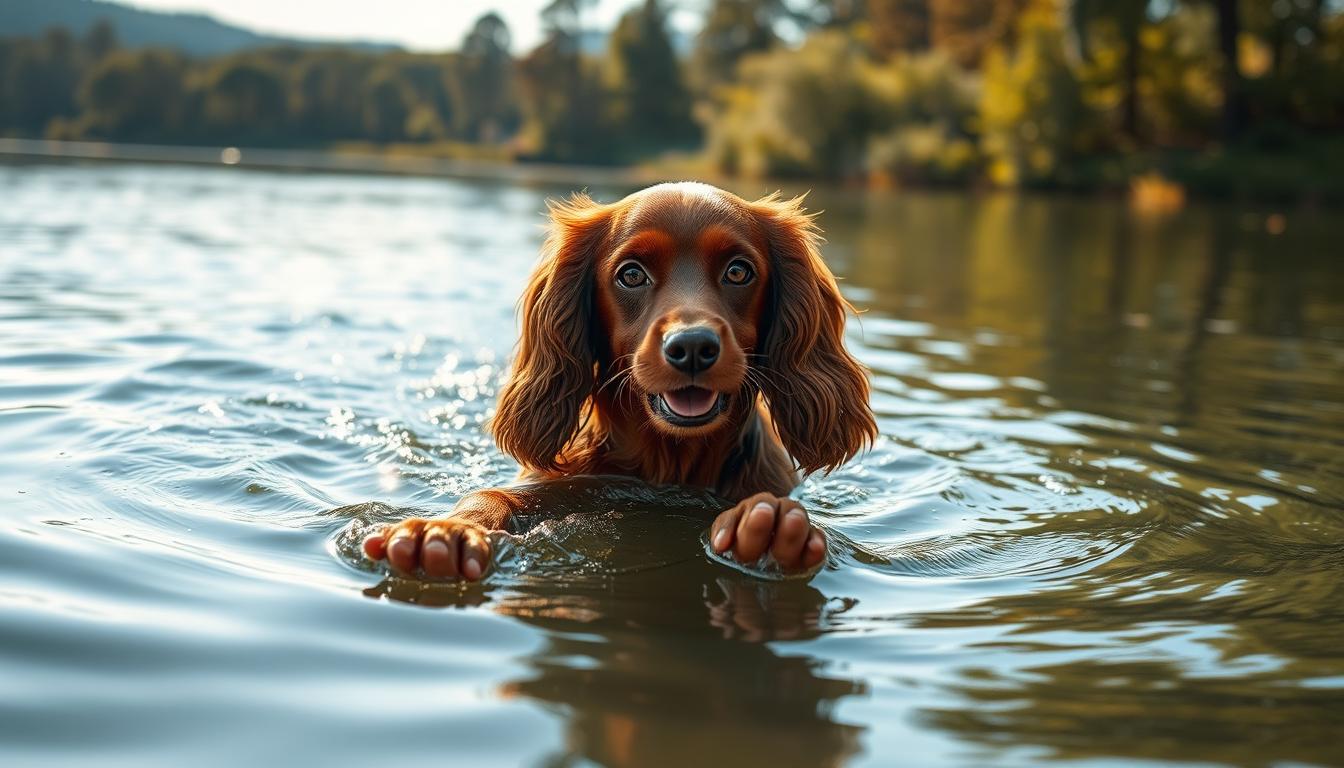Many Australian families cherish their four-legged companions for their energy and adaptability. Sporting dog heritage plays a significant role in shaping these traits, particularly when it comes to aquatic activities. Originally developed for fieldwork, this breed’s history as a versatile hunter gives them an instinctive connection to watery environments.
Their physical features support this affinity. A double-layered coat helps repel moisture, while paddle-like paws provide natural propulsion. These characteristics make splashing about more than just play—it’s a nod to their working roots.
For owners, understanding how to nurture this talent safely is key. Whether at the beach or a local dam, gradual introduction builds confidence. Always supervise your furry friend, especially in unfamiliar settings, to prevent exhaustion or accidents.
Key Takeaways
- Natural water skills stem from historical breeding for hunting and retrieval tasks
- Water-resistant fur and webbed feet enhance aquatic performance
- Early positive experiences shape long-term comfort in wet environments
- Regular checks for ear health prevent infections after swimming sessions
- Life jackets add safety during boating or deep-water adventures
Exploring cocker spaniel swimming ability
In Australia’s diverse landscapes, some breeds naturally excel in aquatic environments. Their physical design and ancestral background create perfect conditions for water-based activities. Let’s examine what makes these dogs stand out.
Built for Wet Environments
Sporting breeds possess unique features that aid water navigation. A double-layered coat acts like a natural wetsuit, while palm-shaped paws create efficient paddles. These traits allow effortless movement through lakes or rivers.
Roots in Water Work
Originally bred for wetland hunting, these companions inherited a love for splashing. Historical records show they retrieved game from English marshes for centuries. This legacy explains their confidence around waves and currents.
| Breed | Coat Type | Webbed Feet | Energy Level |
|---|---|---|---|
| Sporting Spaniels | Water-resistant | Yes | High |
| Traditional Retrievers | Thick undercoat | Yes | Moderate-High |
| Companion Breeds | Varied | No | Low-Moderate |
When introducing water activities, consider their instinctive drive. Start with shallow areas and use floating toys to spark interest. Always match exercises to their stamina levels.
Water Play and Training Tips for Your Cocker Spaniel
Developing aquatic confidence in energetic pups requires thoughtful strategies that balance safety with enjoyment. Building trust through gradual exposure helps create lasting enthusiasm for splashing adventures.

Starting Small: Gradual Introduction to Water
Begin with ankle-deep water in a shaded paddling pool or calm shoreline. Use lukewarm liquid to prevent shock, increasing depth by 2-3cm weekly. Floating toys work wonders for curious pups – toss them just beyond paw reach to spark interest.
| Training Stage | Water Depth | Recommended Activity | Session Duration |
|---|---|---|---|
| Introduction | 5-8cm | Paw dipping | 5-8 minutes |
| Building Confidence | 10-15cm | Treat retrieval | 10-12 minutes |
| Advanced Play | 20-30cm | Floating fetch | 15-20 minutes |
Reward-Based Techniques for Positive Reinforcement
High-value treats like chicken pieces motivate hesitant swimmers. Praise enthusiastically when they retrieve toys or voluntarily enter the pool. Always end sessions while they’re still eager – this creates anticipation for next time.
Combine obedience drills with aquatic fun. Practice “come” commands during fetch games or “stay” cues before toy throws. This dual-purpose approach strengthens both skills and bonding.
Water Safety and Health Considerations
Keeping water activities enjoyable requires smart safety practices. While splashing brings joy, hidden dangers demand attention. Let’s explore how to protect your furry companion while maintaining fun.

Hidden Threats in Still Water
Stagnant ponds and slow-moving creeks pose serious risks. Bacterial infections like leptospirosis attack the liver and kidneys, while botulism toxins target the nervous system. Always check water clarity before letting your pet dive in.
Recent tick treatments create another hazard. “Chemical residues from flea collars can poison fish and frogs,” warns a Sydney vet. Wait 72 hours after application before water play.
Breed-Sensitive Care Strategies
This breed’s physical traits require special attention. Floppy ears trap moisture, raising infection risks. Dry them thoroughly after each swim using cotton pads. Joint issues like hip dysplasia may reduce stamina – watch for laboured paddling.
| Environment | Safety Level | Ideal For |
|---|---|---|
| Ocean beaches | Moderate | Strong swimmers (gentle waves) |
| Chlorinated pools | High | Controlled exercise |
| Flowing rivers | Low-Moderate | Supervised adventures |
Smart Location Choices
Seek out clean, moving water whenever possible. Fast-flowing streams dilute contaminants, while maintained pools offer temperature control. Avoid steep riverbanks that challenge older dogs.
Monitor water temperature closely. Chilly conditions strain smaller bodies, potentially causing muscle cramps. If lips turn blue, exit immediately and wrap in towels.
Conclusion
When the mercury climbs, smart owners find ways to combine exercise with cooling fun for their energetic pets. These intelligent dogs thrive when water play aligns with their historical strengths, creating joyful moments that strengthen human-animal bonds.
Successful aquatic adventures begin with understanding individual limits. Gradual exposure to shallow pools builds confidence, while floating toys turn practice into engaging games. Always match activities to your companion’s age and fitness level – young pups need shorter sessions than seasoned swimmers.
Australian owners benefit from the breed’s natural aptitude for liquid environments. Their water-resistant coats and instinctive paddle strokes make beach trips rewarding. Remember post-swim care: dry those signature floppy ears thoroughly and rinse chlorine from sensitive paws.
With thoughtful preparation, these lively companions transform summer days into splashing celebrations. Whether retrieving sticks at dams or riding gentle waves, shared water experiences create lasting memories while keeping pets fit and happy.



